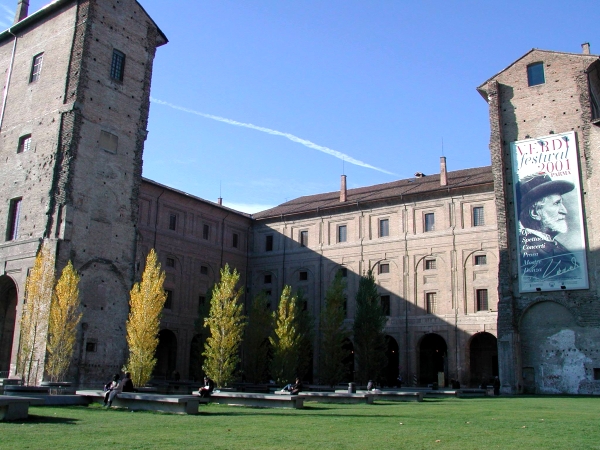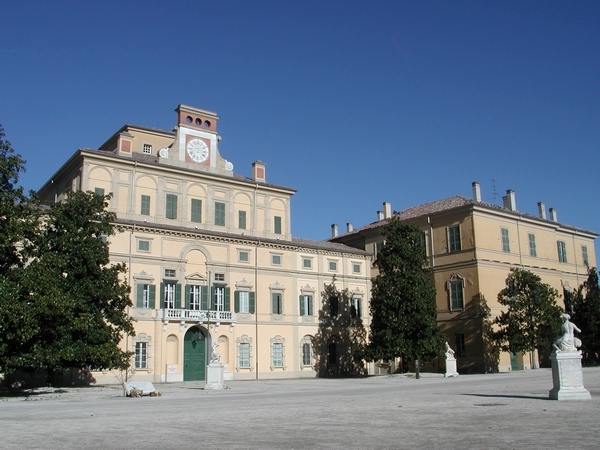Pilotta Palace

The Palace was built by the Farnese, dukes in Parma since 1545. The name "Pilotta" is the Italian word for "Pelota" a Spanish game very popular in the XVI century. This never became the ducal residence but it was used to house all the court services such as the warehouses, the barracks, the stables, the Secret Archive and a huge training hall for the members of the court. The Pilotta Palace was directly connected to the other side of the river by a covered bridge, called "Corridore". The building was never finished. The access to the interior is though an "Imperial" staircase, similar to the one at the Escorial in Madrid, designed by Simone Moschino (the first of this type in Italy). Today the Palace houses the National Gallery, the National Museum of Antiquity, the Farnese Theatre (former training hall), the Palatina Library, the Bodoni Museum and the "Paolo Toschi" Art Institute.
Ducal Palace
The building is located inside the Ducal Park, the Farnese former private garden. It was built starting from 1561 by Jacopo Barozzi, called "Il Vignola" the Pope's architect. Today we see the Neoclassical result of the modifications carried out by Ennemond Alexandre Petitot, court architect, in the second half of XVIII century. On the first floor we enter the noble apartment: the central room is decorated by a vault that depicts more than 200 stucco-birds by Benigno Bossi (1766-1767) while the following rooms are frescoed with scenes from chivalrous literature and mythology, works by Jacopo Bertoja, Girolamo Mirola and Agostino Carracci (XVI century). The Palace is the seat of the Carabinieri and, since 2003, the representative Palace of the E.F.S.A. (European Food Safety Authority).
Rangoni - Farnese Palace
Today seat of the Prefecture, located in via della Repubblica (Emilia Road), the "Parade Street" since antiquity. The Rangoni family bought it in 1527 and in 1690 a part of the building became one of the Farnese residences: the coat of arms of the Dukes of Parma is visible on the façade. When the last Rangoni died in 1762, the building became part of the Ducal Treasure. The main entrance dates clearly back to the late XVII century, flanked by two pseudo telamones which seem to support the balcony above.
Sanvitale Palace
It bears the name of one of the most important among the noble Parma families that gives the name to the small homonymous square. The present building is the result of the works carried out by the Sanvitale along XVIII century unifying several buildings. To the same time dates back the elegant "Imperial" staircase that leads to the first floor. Today is the seat of the Banca Monte Parma where lectures and temporary exhibitions are housed. On the ground floor there's the Amedeo Bocchi Museum.
Grillo - Marchi Palace
Commissioned by Marquis Scipione del Grillo in via della Repubblica, the palace was built from 1770 and 1774 in Neoclassical style. The façade is in mock ashlar-work plaster. Inside the courtyard the scissor-shaped staircase decorated by terracotta statues leads to the first floor. The name of the Palace is the one of the present owner (family Marchi). Today the building is the representative seat of the Arturo Toscanini's Foundation.
Pallavicino Palace
Built in 1646 by Alfonso Pallavicino where once the Sforza di Santafiora Palace was constructed, today it's the seat of the TAR (Regional Court-House). The brick façade dates back to XVIII century. The noble floor houses elegant rooms and a main hall frescoed by Sebastiano Galeotti (beginning of XVIII century).







